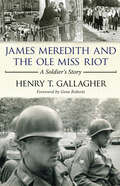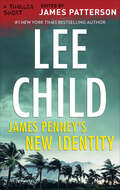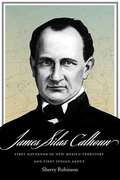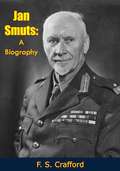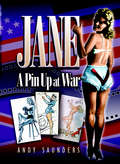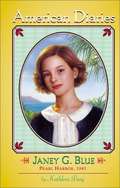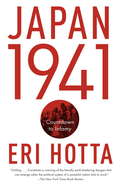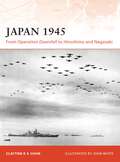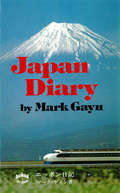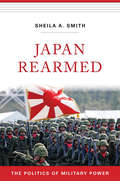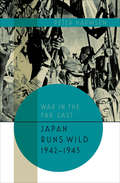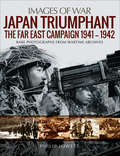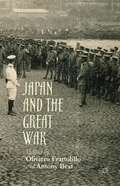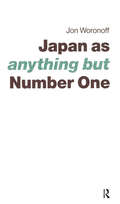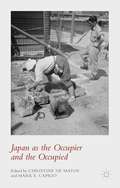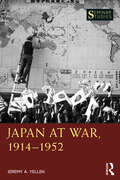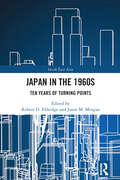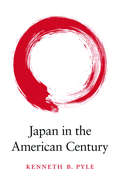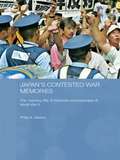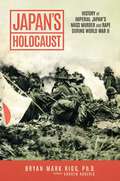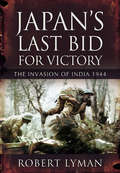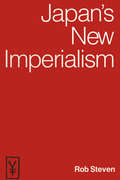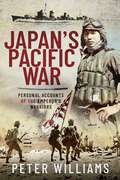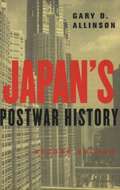- Table View
- List View
James Meredith and the Ole Miss Riot: A Soldier's Story
by Henry T. GallagherIn September 1962, James Meredith became the first African American admitted to the University of Mississippi. A milestone in the civil rights movement, his admission triggered a riot spurred by a mob of three thousand whites from across the South and all but officially stoked by the state's segregationist authorities. Historians have called the Oxford riot nothing less than an insurrection and the worst constitutional crisis since the Civil War. The escalating conflict prompted President John F. Kennedy to send twenty thousand regular army troops, in addition to federalized Mississippi National Guard soldiers, into the civil unrest (ten thousand into the town itself) to quell rioters and restore law and order. James Meredith and the Ole Miss Riot is the memoir of one of the participants, a young army second lieutenant named Henry Gallagher, born and raised in Minnesota. His military police battalion from New Jersey deployed, without the benefit of riot-control practice or advance briefing, into a deadly civil rights confrontation. He was thereafter assigned as the officer-in-charge of Meredith's security detail at a time when he faced very real threats to his life. Gallagher's first-person account considers the performance of his fellow soldiers before and after the riot. He writes of the behavior of the white students, some of them defiant, others perceiving a Communist-inspired Kennedy conspiracy in Meredith's entry into Mississippi's “flagship” university. The author depicts the student, Meredith, a man who at times seemed disconnected with the violent reality that swirled around him, and who even aspired to be freed of his protectors so that he could just be another Ole Miss student. James Meredith and the Ole Miss Riot is both an invaluable perspective on a pivotal moment in American history and an in-depth look at a unique home front military action. From the vantage of the fiftieth anniversary of the riot, Henry T. Gallagher reveals the young man he was in the midst of one of history's most profound tests, a soldier from the Midwest encountering the powder keg of the Old South and its violent racial divisions.
James Penney's New Identity (The Thriller Shorts #4)
by Lee ChildFrom a New York Times–bestseller, a thriller short story about a Vietnam veteran on the run who receives help from a young military cop named Jack Reacher. Before Jack Reacher became the seminal, nomadic hero he is today and #1 New York Times–bestselling writer Lee Child reached his current iconic literary stature, there was James Penney, who we meet in this intense thriller short. Penney was originally envisioned as a character in Child&’s second Jack Reacher tale, Die Trying. Though an interesting character, Penney was ultimately excised during the editing process and readers didn&’t have the pleasure of meeting him. Now he&’s been resurrected in a tale that features a brief glimpse of Jack Reacher&’s early career. Don&’t miss this heart-pumping tale of suspense!
James Silas Calhoun: First Governor of New Mexico Territory and First Indian Agent
by Sherry RobinsonVeteran journalist and author Sherry Robinson presents readers with the first full biography of New Mexico&’s first territorial governor, James Silas Calhoun. Robinson explores Calhoun&’s early life in Georgia and his military service in the Mexican War and how they led him west. Through exhaustive research Robinson shares Calhoun&’s story of arriving in New Mexico in 1849—a turbulent time in the region—to serve as its first Indian agent. Inhabitants were struggling to determine where their allegiances lay; they had historic and cultural ties with Mexico, but the United States offered an abundance of possibilities.An accomplished attorney, judge, legislator, and businessman and an experienced speaker and negotiator who spoke Spanish, Calhoun was uniquely qualified to serve as the first territorial governor only eighteen months into his service. While his time on the New Mexico political scene was brief, he served with passion, intelligence, and goodwill, making him one of the most intriguing political figures in the history of New Mexico.
Jan Smuts: A Biography
by F. S. Crafford‘A just biography of an important figure—political philosopher, soldier in three wars, scientist, statesman—Jan Smuts, who has played a long and decisive role in the formation and consolidation of South Africa. Masterful, energetic, intolerant, often highhanded, Smuts has never been a popular leader, but never once did he deviate from his conception of a united South Africa within the British Empire. Before his Premiership and after, he was to fight steadily against the opposition, the Nationalists, who demanded complete severance from Britain. Other problems of the Indians, of labor rebellion, of industrial unrest, objectively presented. During the First World War, his ruthless leadership in action in East Africa; his important part in world affairs as representative in the British War Cabinet; and later his plan for the League of Nations. He fell from power in 1924, as the anti-British Hertzog came in; he was recalled at 70 to head his country at war for the third time, which he has accomplished with equal severity and decisiveness.‘Sound, factual biography…’ (Kirkus)
Jane: A Pin-Up at War
by Andy SaundersJane was a wartime phenomenon. A sensation. She was also an important feature in the morale of Britain's fighting forces around the world and to those left behind on the "Home Front". So important, in fact, that her fame extended to the House of Commons where one wartime MP referred to our troops as "Jane's fighting men!" Until now there has been no published study of Jane or the woman who inspired her. This book fills the gap with a publication which will have a wide appeal. In a production combining words, photographs and selective cartoons, an in-depth look is taken at the Jane story and, in particular, the beautiful real life model behind that story, Christabel Leighton-Porter. A wealth of pictorial and photographic material exists to illustrate this highly visual story. Much of it has never before seen the light of day. All of it is of high quality and a considerable quantity falls into the 'glamor' category which will appeal to both male and female readers in what is an interesting study of wartime Britain and of Jane's historical and sociological importance of those times.
Janey G. Blue: Pearl Harbor, 1941 (American Diaries)
by Kathleen DueyPearl Harbor, Hawaii, December, 1941. I just hope the war stays far, far away from us. Janey loves the beautiful trees, delicious fruits, and exotic mix of people on the island of Oahu, where her father has come to work at Hickam Airfield. But she's terribly homesick for her friends back in Kansas -- especially with all the frightening talk about war and rumors of a Japanese invasion of Hawaii. Then, on December 7th, Janey's worst nightmares come true. Japanese bombs and bullets shatter the early morning peace. Fleeing with her mother, brother, and Akiko -- the girl across the street, who barely speaks to her -- Janey is terrified for her father at the airfield. During the long, tense hours of worry and fear, Janey must try to find her courage. Will the war turn everything upside down? Will Janey be scared and lonely forever?
Japan 1941: Countdown to Infamy
by Eri HottaA groundbreaking history that considers the attack on Pearl Harbor from the Japanese perspective and is certain to revolutionize how we think of the war in the Pacific. When Japan launched hostilities against the United States in 1941, argues Eri Hotta, its leaders, in large part, understood they were entering a war they were almost certain to lose. Drawing on material little known to Western readers, and barely explored in depth in Japan itself, Hotta poses an essential question: Why did these men--military men, civilian politicians, diplomats, the emperor--put their country and its citizens so unnecessarily in harm's way? Introducing us to the doubters, schemers, and would-be patriots who led their nation into this conflagration, Hotta brilliantly shows us a Japan rarely glimpsed--eager to avoid war but fraught with tensions with the West, blinded by reckless militarism couched in traditional notions of pride and honor, tempted by the gambler's dream of scoring the biggest win against impossible odds and nearly escaping disaster before it finally proved inevitable.In an intimate account of the increasingly heated debates and doomed diplomatic overtures preceding Pearl Harbor, Hotta reveals just how divided Japan's leaders were, right up to (and, in fact, beyond) their eleventh-hour decision to attack. We see a ruling cadre rich in regional ambition and hubris: many of the same leaders seeking to avoid war with the United States continued to adamantly advocate Asian expansionism, hoping to advance, or at least maintain, the occupation of China that began in 1931, unable to end the second Sino-Japanese War and unwilling to acknowledge Washington's hardening disapproval of their continental incursions. Even as Japanese diplomats continued to negotiate with the Roosevelt administration, Matsuoka Yosuke, the egomaniacal foreign minister who relished paying court to both Stalin and Hitler, and his facile supporters cemented Japan's place in the fascist alliance with Germany and Italy--unaware (or unconcerned) that in so doing they destroyed the nation's bona fides with the West. We see a dysfunctional political system in which military leaders reported to both the civilian government and the emperor, creating a structure that facilitated intrigues and stoked a jingoistic rivalry between Japan's army and navy. Roles are recast and blame reexamined as Hotta analyzes the actions and motivations of the hawks and skeptics among Japan's elite. Emperor Hirohito and General Hideki Tojo are newly appraised as we discover how the two men fumbled for a way to avoid war before finally acceding to it. Hotta peels back seventy years of historical mythologizing--both Japanese and Western--to expose all-too-human Japanese leaders torn by doubt in the months preceding the attack, more concerned with saving face than saving lives, finally drawn into war as much by incompetence and lack of political will as by bellicosity. An essential book for any student of the Second World War, this compelling reassessment will forever change the way we remember those days of infamy.
Japan 1945
by John White Clayton ChunIn this 200th Campaign series title Clayton Chun examines the final stages of World War II (1939-1945) as the Allies debated how to bring about the surrender of Japan. Chun not only describes the actual events but also analyzes the possible operations to capture the Japanese mainland which were never implemented. He details Operation Downfall (the planned invasion of the Japanese home islands) and its two-phased approach. Firstly Operation Olympic would see the invasion of Kyushu, followed by Operation Coronet which would see the invasion of the area around Tokyo.Chun goes on to examine exactly why these plans were never implemented, including Allied fears that both military and civilian casualties would be terrible and would result in a long, drawn out war of attrition. He then goes on to examine the horrific alternative to military invasion - the attacks on Hiroshima and Nagasaki with nuclear weapons - which made the Allied threat of "prompt and utter destruction" a reality. With a series of illustrations, including detailed diagrams of the atomic bombs, a depiction of the different stages of the explosions and maps of the original invasion plans, this book provides a unique perspective of a key event in world history.
Japan Diary
by Mark GaynThis book is an eyewitness report of what happened in Japan and Korea during the Occupation years from December 1945 to May 1948.It is also meant to be some other things.<P><P> It is the story of that extraordinary figure General Douglas MacArthur, and the men around him. It is the story of the way American foreign polity operated in one segment of the globe and of the plot and counterplot that went on behind the Japanese throne in the years of war and of the subsequent conspiracy to thwart the Allied purposes. It is the story of the common people in two Oriental lands. It is, finally, the record of the author's education, and not a few readers will find it controversial. But it is an absorbing book nonetheless, and the years that have passed since its first publication have not diminished its value as the chronicle of a highly observant reporter.It is indeed an intriguing panorama that Gayn presents, and whether the reader agrees with him in all of his observations, he can hardly accuse him of being unexciting.
Japan Rearmed: The Politics of Military Power
by Sheila A. SmithModern Japan is not only responding to threats from North Korea and China but is also reevaluating its dependence on the United States, Sheila Smith shows. No longer convinced they can rely on Americans to defend their country, Tokyo’s political leaders are now confronting the possibility that they may need to prepare the nation’s military for war.
Japan Runs Wild, 1942–1943 (War in the Far East #2)
by Peter HarmsenThe author of Storm Clouds Over the Pacific, 1931–1941 chronicles Japan&’s dramatic reversal of fortune as Allied forces gained advantage during WWII. In early 1942, the Imperial Japanese Army and Navy were advancing on all fronts, humiliating Allied forces throughout the Pacific. In a matter of months, Japan had conquered an area larger than Hitler&’s empire at its apex. Hawaiians and Australians feared a future under Hirohito. The fate of half of mankind was hanging in the balance. But by the end of 1943, the tables had turned entirely. The American-led military machine had kicked into gear, and the Japanese were fighting a defensive battle along a frontline that crossed thousands of miles of land and sea. In Japan Runs Wild, 1942–1943, historian Peter Harmsen details the astonishing transformation that took place in that period, setting the Allies on a path to ultimate victory over Japan. The second installment of Peter Harmsen&’s three-part history, Japan Runs Wild, 1942–1943 continues his comprehensive chronicle of the Pacific Theater during the Second World War. Giving due emphasis to the Japanese-American struggle, Harmsen also sheds light on the other peoples involved, including the British, Australians, Soviets, Filipinos, Indians, and Koreans. Above all, the central importance of China is highlighted in a way that no previous general history of the war against Japan has achieved.
Japan Triumphant: The Far East Campaign 1941-1942 (Images of War)
by Philip JowettImperial Japan&’s ambitious offensive at the beginning of WWII is captured in dramatic detail in this pictorial history featuring rare wartime photographs. The Japanese offensive in the Far East in 1941-1942 was extraordinary in its ambition, for their aim was to advance across the entire region. They clashed with an array of forces in a series of lightning campaigns that included famous episodes like the raid on Pearl Harbor and the conquest of Singapore. In this vivid photographic history, historian Philip Jowett covers the whole course of the offensive, portraying not only the Japanese military which achieved such incredible success but the armies they overwhelmed. In a sequence of over 200 wartime photographs—many of which have never been published before—Jowett covers the land, sea, and air fighting as the Japanese occupied so much of the region. Rare images of the Japanese forces as they prepared for war and then made seemingly unstoppable progress are matched with images of the armies they surprised and vanquished. Japan Triumphant captures the character of the war in the Far East, showing the appearance, equipment, and weaponry of the armies involved as well as the conditions in which they fought.
Japan and the Great War
by Antony Best Oliviero FrattolilloIn this book, seven internationally renowned experts on Japanese and Asian history have come together to investigate, with innovative methodological approaches, various aspects of the Japanese experience during and after the First World War.
Japan as (Anything but) Number One
by WoronoffA full scale examination of the 1979 Sino-Vietnamese War - the events that led to it, the Cold War aftermath, and the implications for the region and beyond.
Japan as the Occupier and the Occupied
by Christine De Matos Mark E. CaprioThe moment of Japan's defeat in 1945 artificially dissects its history. Not long after the Meiji Restoration, Japan acquired Ezo (present-day Hokkaido) and the Ryukyu Islands (present-day Okinawa). Later in the Meiji Period it annexed Taiwan, southern Sakhalin, and the Korean peninsula. Before the Asia-Pacific War ended in 1945, Japan controlled territories in China, Manchuria, Southeast Asia and the Pacific but with its acceptance of the Potsdam Declaration in August 1945, Japan lost mostof these acquisitions. Examining issues and experiences as part of either a prewar/wartime or postwar context impedes our ability to understand the influence that one period had on the other. How do occupiers maintain their position of power and influence over the people of the state it occupies? How did Japan's leadership and people manage the transition from that of occupier of other territories to that of being occupied by foreign powers? How did this transition affect different aspects of society, from the civilian to the military, the political to the bureaucratic? How did Japanese occupation affect those it had power over, from dissenters to collaborators? What long term impacts did military occupation have on the occupied in terms of memory, commemoration and repatriation? Japan as the Occupier and the Occupied investigates these types of questions by examining transwar transitions in Japan proper and the various territories that it controlled, including Korea, Borneo, Singapore, Manchuria and China. Through taking this approach, a more nuanced understanding of Japan's role as occupier and occupied emerges. More generally, the book contributes to scholarship on the power dynamics of military occupation and the complexities that emerge during, and in the aftermath of, imperial and military expansion, control, and retreat.
Japan at War, 1914–1952 (Seminar Studies)
by Jeremy A. YellenJapan at War, 1914–1952 is a synthetic and interpretive history that highlights the centrality of war to the modern Japanese experience.The author argues that war was central to Japanese life in this period—the era when Japan rose and fell as a world power. The volume examines how World War I set off profound changes that led to the rise of a politicized military, aggressive imperial expansion, and the militarization of Japanese social, political, and economic life. War was extraordinarily popular, which helped confirm Japan’s aggressive imperialism in the 1930s and war across the Asia-Pacific in the 1940s. It took a defeat by 1945 and occupation through 1952 to undo war as a national concern and to remake Japan into a peaceful nation-state. In telling this story of Japan in war and peace, this book highlights the importance of Japan in the creation of the modern world.This study of political power and its influences in domestic and foreign affairs will be of great value to nonspecialist readers who are interested in this period, undergraduate and postgraduate students in introductory classes, and scholars interested in Japanese history and political, military, and international history.
Japan in the 1960s: Ten Years of Turning Points (Inside East Asia)
by Robert D. Eldridge Jason M. MorganEldridge and Morgan set a new paradigm for East Asian contemporary historiography by viewing the decade of the 1960s as hermeneutically powerful. From street battles over Japan’s security treaty with the United States, to a peace treaty with the former Japanese territory of South Korea, to Japan’s hosting the 1964 Summer Olympics, the 1960s in Japan was a decade of turning points. This book is the first to see the 1960s as a historical subject in its own right and argues that the specificity and internal complexity rooted in East Asia during this period showed how East Asians were dynamic agents in shaping the decade. In this volume, contributors consider Japanese responses to a 1961 coup in the Republic of Korea; the Satō Eisaku administration’s approach to nuclear deterrence and to the question of Okinawa’s return from American control; U.S.-Japan intellectual exchange during the Cold War; support by Japanese businesspeople for the Self-Defense Forces; the “soft power” of Japanese cinema in the 1960s; Japan’s understanding of 1960s United Nations peacekeeping operations; changes in “national polity” discourse in the 1960s; the Dalai Lama’s 1967 visit to Japan; economic development in and cultural exchange between 1960s Japan and Spain; Japan’s science and technology interactions with the United States; and the earliest known, and suspected, cases of North Korean abduction of Japanese citizens. Much of the information in this volume has never appeared in English before.This is an important volume for historians, political scientists, sociologists, and other scholars specializing in the twentieth century and those interested in cutting-edge history-writing about a transformative 10-year period in East Asia.
Japan in the American Century
by Kenneth B. PyleNo nation was more deeply affected by America’s rise to power than Japan. The price paid to end the most intrusive reconstruction of a nation in modern history was a cold war alliance with the U.S. that ensured American dominance in the region. Kenneth Pyle offers a thoughtful history of this relationship at a time when the alliance is changing.
Japan's Contested War Memories: The 'Memory Rifts' in Historical Consciousness of World War II (Routledge Contemporary Japan Series #10)
by Philip A. SeatonJapan's Contested War Memories is an important and significant book that explores the struggles within contemporary Japanese society to come to terms with Second World War history. Focusing particularly on 1972 onwards, the period starts with the normalization of relations with China and the return of Okinawa to Japan in 1972, and ends with the sixtieth anniversary commemorations. Analyzing the variety of ways in which the Japanese people narrate, contest and interpret the past, the book is also a major critique of the way the subject has been treated in much of the English-language. Philip Seaton concludes that war history in Japan today is more divisive and widely argued over than in any of the other major Second World War combatant nations. Providing a sharp contrast to the many orthodox statements about Japanese 'ignorance', amnesia' and 'denial' about the war, this is an engaging and illuminating study that will appeal to scholars and students of Japanese history, politics, cultural studies, society and memory theory.
Japan's Economic Planning and Mobilization in Wartime, 1930s-1940s
by Yoshiro MiwaAlthough most economists maintain a (justifiable) mistrust of a government's goals when it intervenes in an economy, many continue to trust its actual ability. They retain, in other words, a faith in state competence. For this faith, they adduce no evidence. Sharing little skepticism about the government ability, they continue to expect the best of governmental intervention. To study government competence in World War II Japan offers an intriguing laboratory. After all, governments direct wars. They decide whether to prepare for them, when to initiate them, how to execute them, and the terms on which to end them. Toward that end, the public sometimes grants them as much power as it can feasibly grant. And in Japan during World War II, the public granted the state the maximum power. In this book, Yoshiro Miwa shows that the Japanese government did not conduct requisite planning for the war by any means. It made its choices on an ad hoc basis, and the war itself quickly became a dead end. That the government planned for the war incompetently casts doubts on the accounts of Japanese government leadership more generally.
Japan's Holocaust: History of Imperial Japan's Mass Murder and Rape During World War II
by Bryan Mark RiggJapan&’s Holocaust is a comprehensive exploration of Japan&’s mass murder and sexual crimes during the Pacific and Asian Wars from 1927 to 1945.Japan&’s Holocaust combines research conducted in over eighteen research facilities in five nations to explore Imperial Japan&’s atrocities from 1927 to 1945 during its military expansions and reckless campaigns throughout Asia and the Pacific. This book brings together the most recent scholarship and new primary research to ascertain that Japan claimed a minimum of thirty million lives, slaughtering far more than Hitler&’s Nazi Germany. Japan&’s Holocaust shows that Emperor Hirohito not only knew about the atrocities his legions committed, but actually ordered them. He did nothing to stop them when they exceeded even the most depraved person&’s imagination, as illustrated during the Rape of Nanking as well as many other events. Japan&’s Holocaust will document in painful detail that the Rape of Nanking was not an isolated event during the Asian War but rather representative of how Japan behaved for all its campaigns throughout Asia and the Pacific from 1927 to 1945.Mass murder, rape, and economic exploitation was Japan&’s modus operandi during this time period, and whereas Hitler&’s SS Death&’s Head outfits attempted to hide their atrocities, Hirohito&’s legions committed their atrocities out in the open with fanfare and enthusiasm. Moreover, whereas Germany has done much since World War II to atone for its crimes and to document them, Japan has been absolutely disgraceful with its reparations for its crimes and in its efforts to educate its population about its wartime past. Shockingly, Japan continues, in general, to glorify is criminals and its wartime past.
Japan's Last Bid for Victory: The Invasion of India, 1944
by Robert LymanEven by SAS standards this is the story of an outstanding warrior.On the point of being demobbed from the SAS, Fred Marafono was recruited by David Stirling for his private security company. After Stirlings death, Fred found himself in the midst of Sierra Leones Blood Diamond wars, and formed an unbreakable bonding with the countrys champion of democracy, Chief Hinga Norman, whose leadership and tragic death are integral to the story.Fred was recruited by Simon Mann for the finest of all private military companies in Africa, Executive Outcomes. Fewer than two hundred of them defeated the rebels in their strongholds. Through political weakness, Executive Outcomes were made to leave the country, and chaos ensued. Committed men like Hinga Norman and British High Commissioner Peter Penfold saw that in the absence of military commitment from the west, only high caliber mercenaries would win the fight to restore democracy: three of them kept a vital air bridge open ? What God abandoned, these defended. Freds final action was supporting the SAS in their brilliant hostage release, Operation Barras.Peter Penfold sums it all up in the books foreword, writing of the, confidence, trust and admiration I have for this remarkable man.
Japan's New Imperialism (Japan In The Modern World Ser.)
by Rob StevenA full scale examination of the 1979 Sino-Vietnamese War - the events that led to it, the Cold War aftermath, and the implications for the region and beyond.
Japan's Pacific War: Personal Accounts of the Emperor's Warriors
by Peter Williams‘I had no qualms fighting the Australians, just as I have killed without remorse any of the Emperor’s enemies: the British, the Americans and the Dutch’, so admits Takahiro Sato in this ground-breaking oral history of Japan’s Pacific War. Thanks to years of research and over 100 interviews with veterans, the Author has compiled a fascinating collection of personal accounts by former Japanese soldiers, sailors and airmen. Their candid views are often provocative and shocking. There are admissions of brutality, the killing of prisoners and cannibalism. Stark descriptions of appalling conditions and bitter fighting blend with descriptions of family life. Their views on the prowess of the enemy differ with some like air ace Kazuo Tsunoda who believed the Australians ‘worthy’. Some remain unrepentant while others such as Hideo Abe are ashamed of his part in Japan’s war of aggression. The result is a revealing insight into the minds of a ruthless and formidable enemy which provides the reader with a fresh perspective on the Second World War.
Japan's Postwar History
by Gary D. AllinsonJapan's Postwar History presents the first integrated analysis of the social, economic, and political changes that Japan has experienced since 1945. Drawing on more than three decades of first-hand experience with the country, Gary D. Allinson depicts a dynamic, often turbulent history and illuminates its impact on individuals, families, and communities. Between 1932 and 1952, war, devastation, and foreign occupation caused significant changes in Japan. However, the society that emerged during the 1950s still resembled its prewar predecessor in many ways, according to Allinson. Thereafter, by exploiting a fortunate combination of domestic and international conditions the Japanese people ushered in twenty years of extensive development. Growth created problems as well as profits and imposed some wrenching adjustments after the world economic crises of 1973 and 1979. Nonetheless, Japanese society steadily assimilated the benefits of affluence, Allinson argues. Until worldwide recession drew Japan into a severe economic downturn in the late 1980s, it continued to adapt to the social and political demands of a rich nation enmeshed in a global economy. By the mid-1990s, Japan had reached the end of a cycle of historical change. Plagued with uncertainty and striving to find a formula for regeneration, Japan once again found itself confronting the dilemmas of inequality, instability, and insecurity.
